#australasian history
Explore tagged Tumblr posts
Text
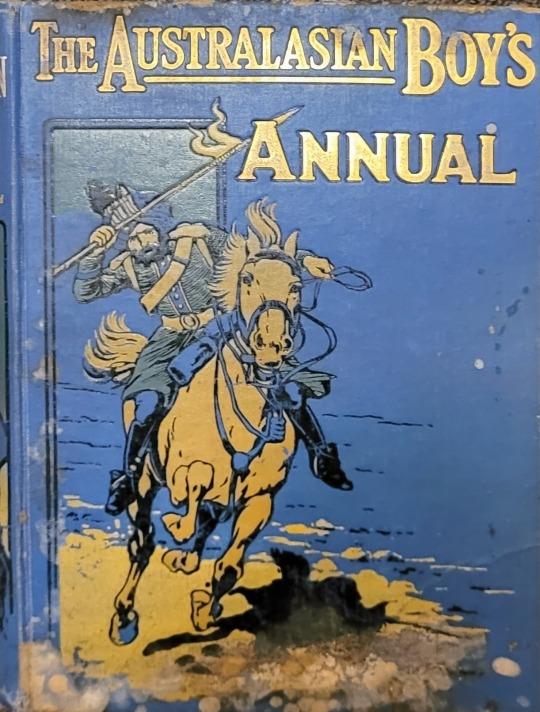
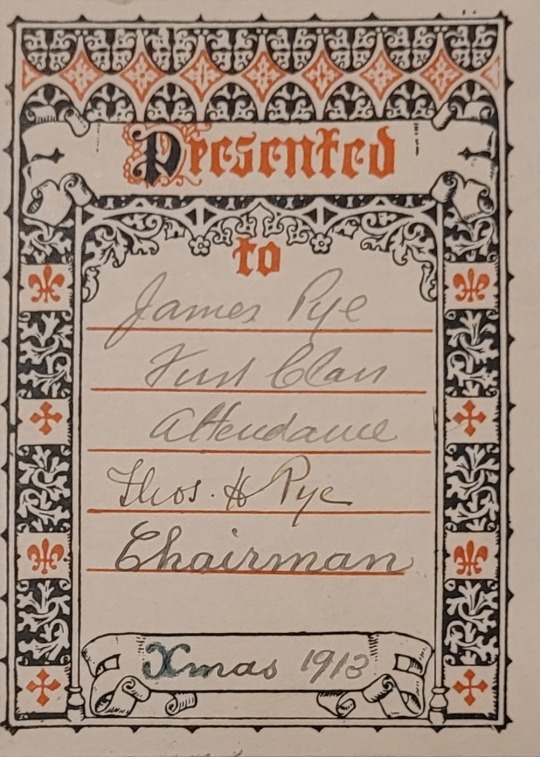
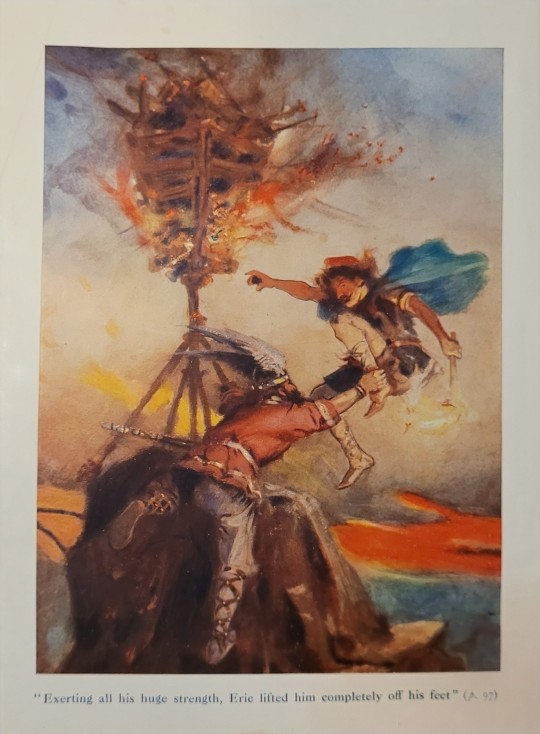
rather moldy copy of the 1913 australasian boy's annual that i picked up in an op shop down south last summer. the plate in the front says it was presented to one James Pye for 'first class attendance' at christmas of 1913.
#attendance to what i don't know#possibly scouts due to the fleur de lis motif but could also just be a school... though chairman seems more scouting#also the chairman has the same last name .. maybe a brother#cool piece of history for $10 anyways#boy's annual#annual#australian history#new zealand history#australasian history#australian books#1910s#10s#vintage books#antique books#old books
6 notes
·
View notes
Text
For #Woodensday:
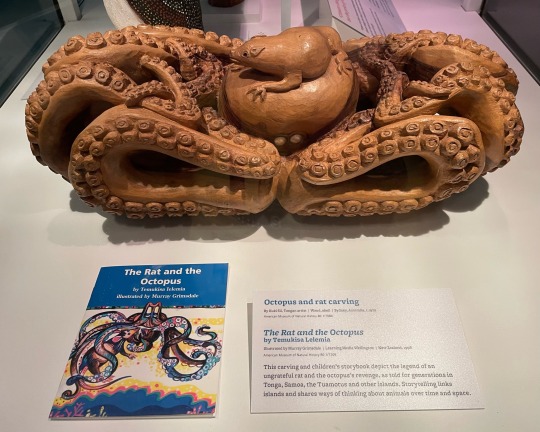
Octopus and Rat by Kuki Sii, Tongan artist wood carving w/ shell Sydney, Australia c.1970 + The Rat and the Octopus book by Temukisa Lelemia, illustrated by Murray Grimsdale Wellington, New Zealand 1998
“This carving and children's storybook depict the legend of an ungrateful rat and the octopus' revenge, as told for generations in Tonga, Samoa, the Tuamotus and other islands. Storytelling links islands and shares ways of thinkitig about animals over time and space.”
On display at American Museum of Natural History in NYC.


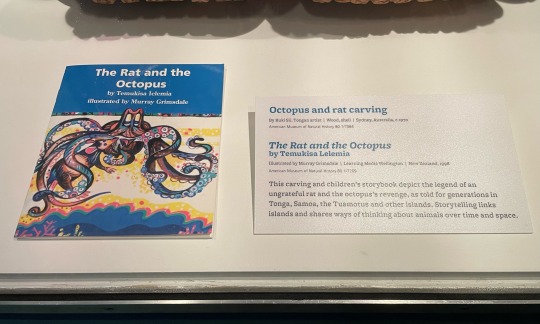
#octopus#rat#cephalopods#rodents#The Rat and the Octopus#Australian art#New Zealand art#Australasian art#Oceanic art#Oceania#wood carving#book#folktale#American Museum of Natural History#museum visit#Woodensday#animals in art
109 notes
·
View notes
Text
Australia’s Favourite Craft Beer Festival is Back for a Whirlwind Tour in June - GABS
Attention beer lovers! It’s time to clear your schedule as the Great Australasian Beer SpecTAPular (GABS) festival is back and bigger than ever in 2024! If this will be your first GABS experience, you’re in for a treat. With over 500+ beers on tap to choose from, all under one roof, you won’t know which way to turn. Over 120 different breweries from all over Australia and New Zealand will be…
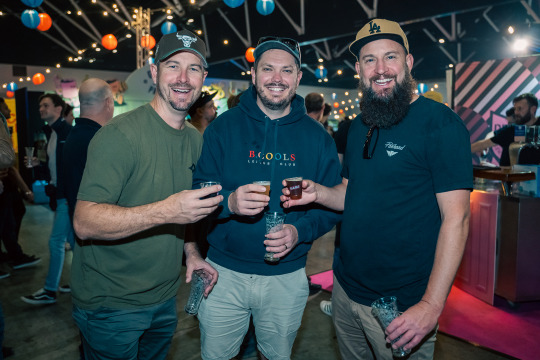
View On WordPress
#Australia#Bavarian Government.#beer competition#beer event#beer festival#beer lovers#beer prizes#Beer Tasting#beer tour#beer trip#Benedictine monks#breweries#brewery showcase#brewing history#brewing traditions#Brisbane#Brisbane Convention Centre#Craft Beer#creative brews#festival tickets#Freising Volksfest#GABS festival#Germany#Great Australasian Beer SpecTAPular#ICC Sydney#international brews#Melbourne#Melbourne Showgrounds#New Zealand#Rocky Road beer
0 notes
Note
I'm trying to develop my worldbuilding but have run into a problem. I don't want to do what usual fantasy settings do where specific "races" have very specific personality and cultural traits, so I'm trying to make a setting with different anthropomorphic "races" coexisting to different extents. The problem is, anytime I question myself on how somehow could've happened or how the different species ended up in their current sociopolitical climate, I don't know when to stop. If it were for me, I'd go as far back as the discovery of fire. How do you know when to stop?
Ideally you never stop, but I understand that sometimes you want to get on with a story. And that's another thing about worldbuilding, once you start creating a world different from Earth, you start asking yourself... well, why this world had the same evolution as Earth, wouldn't different geography result in different species? And then you go into speculative biology and speculative evolution and that's a rabbit hole you will never get out of. And more, you can say, why should this world have the same day length, year length, axial tilt, size as Earth... and THAT'S when you do worldbuilding for real, the worldbuilding never ends.
But here's a tip to make it easier. If you don't know something, if you don't know how to stop, you can always draw from real-life Earth. For example, let's say that you don't want to do the entire evolution of life. You have a cheat sheet; you can use the Biogeographic Realms, and mix and match fauna and flora, and you can assume evolution took a relatively Earth-like turn since your world's continents formed. You have all the life you would expect from regular Earth, and you add your own twists as needed.
For example, in one project, I wanted a Southern hemisphere vibe, so I created a world where the flora and fauna are Neotropical (South American) and Australasian, with some extinct creatures from those places, which is totally justifiable because many species can stay alive for a long time even extinct elsewhere. I just assumed that evolution followed roughly the same path there, which for a fantasy world with actual gods is more than fine.
If you are stuck in certain places on how to create your civilizations, you have literally all of human history and culture to draw from. If you don't know how civilizations in jungles develop, for example, it's time to learn about the Maya and wider Mesoamerica, Srivijaya and Majapahit, the kingdoms of Western Africa like Dahomey, Benin, Oyo, the cultures of the Amazon... Every place in this planet is full of vibrant history, culture and solutions to problems that make for great worldbuilding. You have to be careful about taking inspirations from real life cultures, but it's better that you learn about them rather than not doing research at all!
This is why I insist that people learn about real-life geography and history. Not because CINEMASINS DING, but because once you do, worldbuilding becomes easy and fun. Once you learn the rules about how the real world works, you can twist them and break them as you wish.
112 notes
·
View notes
Text
I was awestruck by this display. The density of detail between the buildings, people, and ships, is almost overwhelming. This was the last diorama of the series (or the first depending on which way you were coming from). The California State Railroad Museum in Sacramento was worth visiting for this series of dioramas alone.
*Smuggler’s Cove*
This O scale narrow gauge layout, Smuggler’s Cove, built by Michael Flack and the late Geoff Knott in Australia, depicts a fictional New England fishing community modeled after towns in coastal Massachusetts and Maine. Small and large fishing boats and the steamboat Sabino near the Maritime Museum play a prominent role in this coastal diorama. Look for intricate details such as the scratch built lobster traps, floats, and fish crates stacked on the pier. How many seagulls can you spot in Smuggler’s Cove?
*Geoff Knott and Michael Flack*
The late Geoff Knott and Michael Flack were insprred to build Smuggler’s Cove after discovering the history of rum-running along the East Coast of the US, in the carly 1900s, their inspiration for Smuggler’s Cove came after Geoff and Michael traveled to New England and visited Cape Cod, Boothbay Harbor, Bar Harbor, and Kennebunkport, Geoff and Michael helped to popularize O scale models. <Layout furnished by the Australasian Region of the NMRA>.

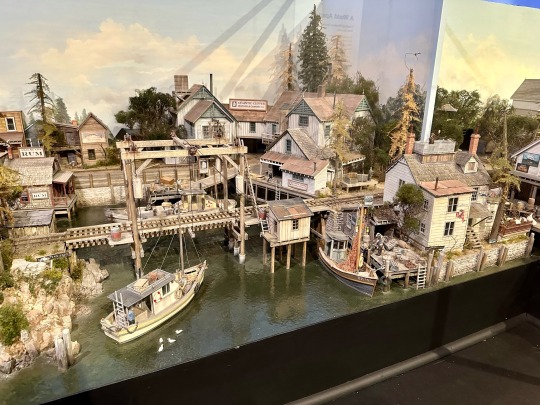

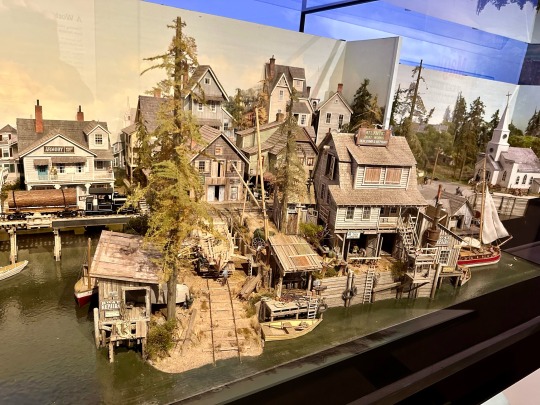
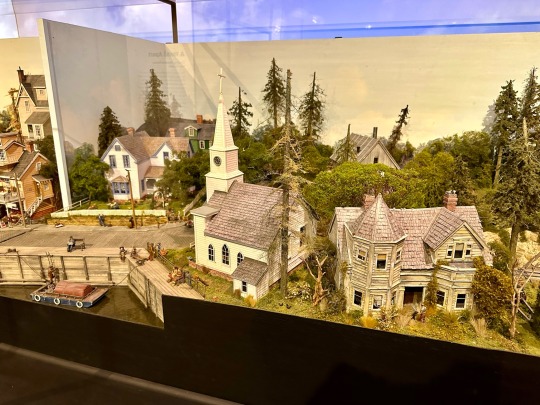
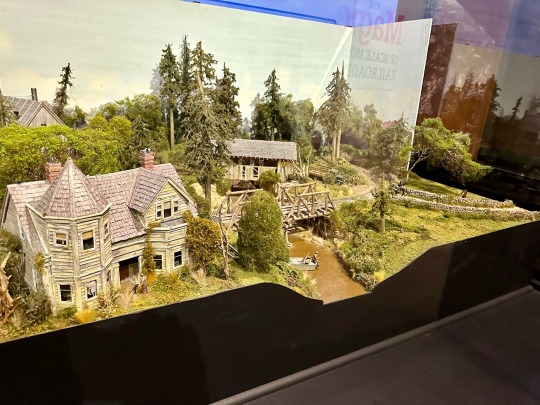
#miniatures#minipainting#miniature painting#terrain#painting miniatures#terrain inspiration#painting terrain#diorama#scale model railroad#scale model#railroad museum#model railway#model railroad#railroad#railway
77 notes
·
View notes
Text
books and articles about about comics, superheroes, dc and batman
books Ahrens, J., & Meteling, A. (Eds.). (2010). Comics and the City: Urban Space in Print, Picture and Sequence. A&C Black.
Bongco, M. (2014). Reading comics: Language, culture, and the concept of the superhero in comic books. Routledge.
Brode, D. (Ed.). (2022). The DC Comics Universe: Critical Essays. McFarland.
Brooker, W. (2013). Batman unmasked: Analyzing a cultural icon. Bloomsbury Publishing USA.
Burke, L., Gordon, I., & Ndalianis, A. (Eds.). (2020). The superhero symbol: media, culture, and politics. Rutgers University Press.
Dittmer, J., & Bos, D. (2019). Popular culture, geopolitics, and identity. Rowman & Littlefield.
DiPaolo, M. (2014). War, politics and superheroes: Ethics and propaganda in comics and film. McFarland.
Dyer, B. (Ed.). (2009). Supervillains and Philosophy: sometimes, evil is its own reward (Vol. 42). Open Court Publishing.
Geaman, K. L. (Ed.). (2015). Dick Grayson, boy wonder: Scholars and creators on 75 years of Robin, Nightwing and Batman. McFarland.
Giddens, T. (Ed.). (2015). Graphic justice: Intersections of comics and law. Routledge.
Heer, J., & Worcester, K. (Eds.). (2009). A comics studies reader. Univ. Press of Mississippi.
Irwin, W. (2009). Batman and philosophy: The dark knight of the soul. John Wiley & Sons.
Langley, T. (2022). Batman and psychology: A dark and stormy knight. Turner Publishing Company.
McKittrick, C. (2015). Fan phenomena: Batman, edited by Liam Burke.
Ndalianis, A. (Ed.). (2009). The contemporary comic book superhero (Vol. 19). Routledge.
O'Connor, L. R. (2021). Robin and the Making of American Adolescence. Rutgers University Press.
O'Neil, D., & Wilson, L. (Eds.). (2008). Batman Unauthorized: Vigilantes, Jokers, and Heroes in Gotham City. BenBella Books.
Packer, S., & Fredrick, D. R. (Eds.). (2020). Welcome to Arkham Asylum: Essays on Psychiatry and the Gotham City Institution. McFarland.
Pearson, R., & Uricchio, W. (Eds.). (2023). The many lives of the Batman: Critical approaches to a superhero and his media. Taylor & Francis.
Pearson, R., Uricchio, W., & Brooker, W. (Eds.). (2017). Many more lives of The Batman. Bloomsbury Publishing.
Picariello, D. K. (Ed.). (2019). Politics in Gotham: the Batman universe and political thought. Springer.
Pustz, M. (Ed.). (2012). Comic books and American cultural history: An anthology. Bloomsbury Publishing USA.
Romagnoli, A. S., & Pagnucci, G. S. (2013). Enter the superheroes: American values, culture, and the canon of superhero literature. Scarecrow Press.
Smith, M. J., & Duncan, R. (Eds.). (2012). Critical approaches to comics: Theories and methods. Routledge.
Smith, M. J., Brown, M., & Duncan, R. (Eds.). (2019). More critical approaches to comics: theories and methods. Routledge.
Weiner, R. G. (Ed.). (2009). Captain America and the struggle of the superhero: Critical essays. McFarland.
Weldon, G. (2017). The caped crusade: Batman and the rise of nerd culture. Simon and Schuster.
White, M. D. (2019). Batman and ethics. John Wiley & Sons.
Worcester, K., Heer, J., & Hatfield, C. (Eds.). (2013). The Superhero Reader. University Press of Mississippi.
articles Authers, B. (2012). What Had Been Many Became One: Continuity, the Common Law, and Crisis on Infinite Earths. Law Text Culture, 16, i.
Austin, S. (2015). Batman's female foes: the gender war in Gotham City. Journal of Popular Culture (Boston), 48(2), 285-295.
Avery, C. (2023). Paternalism, performative masculinity and the post-9/11 cowboy in Christopher Nolan’s Dark Knight trilogy. The Australasian Journal of Popular Culture, 12(1), 65-81.
Bainbridge, J. (2007). “This is the Authority. This Planet is Under Our Protection”—An Exegesis of Superheroes' Interrogations of Law. Law, Culture and the Humanities, 3(3), 455-476.
Best, M. (2005). Domesticity, homosociality, and male power in superhero comics of the 1950s. Iowa Journal of Cultural Studies, 6(1).
Brienza, C. (2010). Producing comics culture: a sociological approach to the study of comics. Journal of Graphic Novels and Comics, 1(2), 105-119.
Camp, L. D. (2017). ‘Time to ride the monster train’: multiplicity, the Midnighter and the threat to hegemonic superhero masculinity. Journal of Graphic Novels and Comics, 8(5), 464-479.
Camp, L. D. (2018). "Be of Knightly Countenance": Masculine Violence and Managing Affect in Late Medieval Alliterative Poetry and Batman: Under The Red Hood (Doctoral dissertation, University of South Carolina).
Cocca, C. (2014). Negotiating the third wave of feminism in Wonder Woman. PS: Political Science & Politics, 47(1), 98-103.
Coogan, P. (2018). Wonder Woman: superheroine, not superhero. Journal of Graphic Novels and Comics, 9(6), 566-580.
Cohn, N., Hacımusaoğlu, I., & Klomberg, B. (2023). The framing of subjectivity: Point-of-view in a cross-cultural analysis of comics. Journal of Graphic Novels and Comics, 14(3), 336-350.
Costello, M. J., & Worcester, K. (2014). The politics of the superhero: Introduction. PS: Political Science & Politics, 47(1), 85-89.
Crutcher, P. A. (2011). Complexity in the comic and graphic novel medium: Inquiry through bestselling Batman stories. The Journal of Popular Culture, 44(1), 53-72.
Curtis, N. (2013). Superheroes and the contradiction of sovereignty. Journal of Graphic Novels and Comics, 4(2), 209-222.
Fennell, J. (2012). The aesthetics of supervillainy. Law Text Culture, 16, i.
Giddens, T. (2015). Natural law and vengeance: Jurisprudence on the streets of Gotham. International Journal for the Semiotics of Law-Revue internationale de Sémiotique juridique, 28(4), 765-785.
Guynes, S. (2019). Worlds Will Live, Worlds Will Die: Crisis on Infinite Earths and the Anxieties and Calamities of the Comic-Book Event. Inks: The Journal of the Comics Studies Society, 3(2), 171-190.
Hall, K. J., & Lucal, B. (1999). Tapping into parallel universes: Using superhero comic books in sociology courses. Teaching sociology, 27(1), 60-66.
Hatchell, R. (2023). ‘We prefer protégé’: The temporal function of sidekicks in Young Justice and Titans. The Australasian Journal of Popular Culture, 12(1), 83-97.
Jeong, S. H. (2020). Sovereign Agents of Mythical and (Pseudo-) Divine Violence. Walter Benjamin and Global Biopolitical Cinema. The Philosophical Journal of Conflict and Violence, 4(2), 81-98.
Jimenez, P. (2021). Wonder Woman, Feminist Icon? Queer Icon? No, Love Icon. In Wonder Woman (pp. 23-36). Routledge.
Lang, R. (1990). Batman and Robin: A family romance. American imago, 47(3/4), 293-319.
Petrovic, P. (2016). Queer resistance, gender performance, and ‘coming out’of the panel borders in Greg Rucka and JH Williams III’s Batwoman: Elegy. In Superheroes and Identities (pp. 221-230). Routledge.
Philips, M. (2022). Violence in the American imaginary: Gender, race, and the politics of superheroes. American Political Science Review, 116(2), 470-483.
Pitkethly, C. (2016). The pursuit of identity in the face of paradox: indeterminacy, structure and repetition in Superman, Batman and Wonder Woman. In Superheroes and Identities (pp. 87-94). Routledge.
Powell, T. (2023). ‘You’re a refugee, are you not?’‘Extraordinary bodies’, monstrous outsiders and US refugee policies in superhero comics. The Australasian Journal of Popular Culture, 12(1), 9-20.
Romero, L. G., & Dahlman, I. (2012). Justice framed: Law in comics and graphic novels. Law Text Culture, 16, vii.
Schott, G. (2010). From fan appropriation to industry re-appropriation: the sexual identity of comic superheroes. Journal of Graphic Novels and Comics, 1(1), 17-29.
Sereni, E. (2020). "When I'm Bad, I'm Better": from early Villainesses to contemporary antiheroines in superhero comics.
Sharp, C. (2012). 'Riddle me this…? 'would the world need superheroes if the law could actually deliver justice'?. Law Text Culture, 16, 353-378.
Shyminsky, N. (2011). ‘‘Gay’’ Sidekicks: Queer Anxiety and the Narrative Straightening of the Superhero. Men and Masculinities, 14(3), 288-308.
Valentine, G. (2021). Empire of a wicked woman: Catwoman, royalty, and the making of a comics icon. In Wonder Woman (pp. 93-112). Routledge.
Weston, G. (2013). Superheroes and comic-book vigilantes versus real-life vigilantes: an anthropological answer to the Kick-Ass paradox. Journal of Graphic Novels and Comics, 4(2), 223-234.
Whaley, D. E. (2011). Black cat got your tongue?: Catwoman, blackness, and the alchemy of postracialism. Journal of Graphic Novels and Comics, 2(1), 3-23.
Wolf-Meyer, M. J. (2006). Batman and Robin in the nude, or class and its exceptions. Extrapolation (pre-2012), 47(2), 187.
York, C. (2000). All in the Family: Homophobia and Batman Comics in the 1950s. International Journal of Comic Art, 2(2), 100-110.
29 notes
·
View notes
Text
a too-common misconception about the origins of filipinos is that we are all descended from the aeta. we are not. “aeta” refers to a specific ethnic group native to certain places in luzon such as zambales and pampanga, but is also commonly used as an umbrella term for several related ethnic groups across the philippine archipelago. they are identified by physical characteristics such as dark skin and very curly hair (leading to a false belief that they are descendants of black africans) as opposed to those of majority of the country who have lighter skin and hair that is either straight or of looser curl patterns (also falsely believed to be markers of the so-called malay race.)
the aeta are an ethnic minority; as of 2010, there were a documented <100,000 out of millions of filipino citizens identifying as such. it is clear majority of filipinos are not of aeta descent. so where does this myth that all filipinos “descend” from the aeta come from?
generations of miseducation has led the average filipino to believe that, out of the hundreds of ethnic groups native to the philippines, it is the aeta in particular who are the original people who came to the philippines prior to the advent of the austronesian expansion. in other words, filipinos view the aeta as a pure people who are remnants of the old world.
this is not true because:
DNA evidence from the luzon aeta, mamanwa ata, batak, & other similar peoples indicate ancestry from BOTH the earliest settlers of what is now the philippines (commonly referred to colloquially and in the literature as negritos but also sometimes as basal australasians and first sundaland peoples) and later migrants associated with the austronesian expansion.
all other native populations in the philippines save for igorot peoples also show admixture from both negrito/basal australasian/first sundaland peoples and later migrants, most significantly the austronesian speakers. what’s notable is the varying degrees of admixture among aetas and non-aetas.

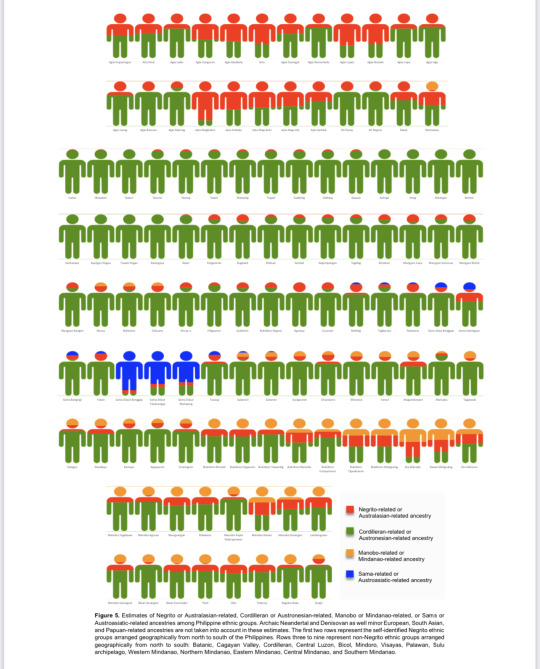
two graphic charts showing the peopling of the philippines and genetic admixture in modern populations. taken from the study, “Multiple migrations to the Philippines during the last 50,000 years” (2021) by Maximillian Larena et al.
i think what has happened is that “aeta” has become synonymous with the earliest inhabitants of the philippines, the real name for these ancient peoples being unknown to us moderns. it is only the flawed tendency to view indigenous peoples as unchanging relics of the past that has led to the biggest mistake filipinos make when discussing our origins: that is, the constant misuse of the term “aeta” to mean “pureblooded original people” when in reality aeta peoples are also descended from later migrants. when people say filipinos are descended from the aeta, they really mean to say filipinos are descended from the first settlers.
aeta peoples are our contemporaries; they are not our living progenitors but their own people with their own languages, ancestral lands, cultures, and histories.
#philippines#indigenous peoples#pseudoscience#southeast asia#genetics#aeta peoples#sundaland#basal australasian#first sundaland peoples#austronesian#x
115 notes
·
View notes
Text
Frozen Perseverance: The Trials of Early Antarctic Explorers

In the heart of Antarctica, where the wind howls at 100 mph and the cold gnaws at flesh, a group of explorers sought to conquer the unknown. Inside the shelter of the First Australasian Antarctic Expedition (1911-1914), men gathered in their cramped kitchen, melting snow for water and rationing what little food they had. Just outside, Xavier Mertz climbed out through a trapdoor in the roof—the entire building had been buried under snow, leaving only this narrow escape. Survival in Antarctica was not just about endurance but about adapting to an environment that constantly threatened to consume them.
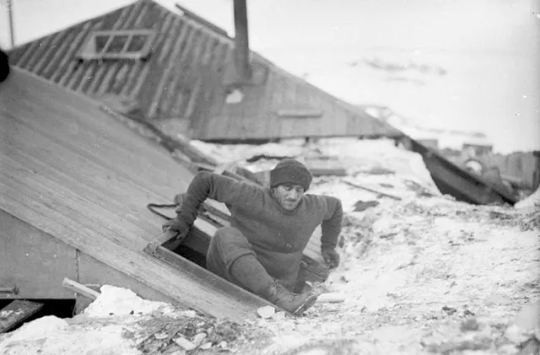
The ice showed no mercy. Cecil Madigan, a meteorologist on the Australasian Antarctic Expedition, stood outside, his face covered in snow, a stark reminder of the brutal conditions they endured daily. Meanwhile, a team of hardy Siberian huskies pulled a sled carrying an expedition member across the frozen expanse, their breath visible in the frigid air. These dogs were more than companions; they were the backbone of Antarctic travel, hauling supplies through the endless ice fields. But even with their help, the journey was perilous, and not all would survive the treacherous terrain.


Disaster struck when Belgrave Ninnis, an officer and surveyor, fell through a hidden crevasse, taking most of the food and supplies with him. With no other option, Douglas Mawson and Xavier Mertz were forced to eat their sled dogs to stave off starvation. The extreme diet took its toll—Mertz succumbed to malnutrition and poisoning from consuming the dogs' liver, collapsing on the ice. As Mawson struggled to make it back alone, another expedition was facing its own catastrophe: Ernest Shackleton’s ship, Endurance, had become trapped in ice in 1915, leaving his crew stranded in the middle of the Weddell Sea.


For months, Shackleton and his men watched helplessly as Endurance groaned under the relentless pressure of the ice. When it was finally crushed and sank, they were left with no choice but to attempt a daring escape across the frozen wasteland. Meanwhile, back on the Australasian Antarctic Expedition, Mawson, now completely alone, carved his way through the ice, leaning into the brutal 100 mph winds in a desperate bid to survive. The fate of both expeditions hung in the balance, as Antarctica tested the limits of human resilience.


Then, against all odds, salvation appeared. In 1916, a small rescue ship finally reached Elephant Island, where Shackleton’s men had been stranded for months. Miraculously, every one of them survived. Meanwhile, photographer Frank Hurley, who documented the Endurance expedition, captured haunting images of the frozen ship just before it was lost to the ice forever. These photographs, along with the stories of Mawson, Mertz, and Shackleton’s crew, remain a testament to one of history’s greatest survival tales—where courage, determination, and sheer willpower triumphed over the most hostile place on Earth.


7 notes
·
View notes
Text
AIT or Aryan Invasion Theory (debunked): A superior "race" of white, horse-riding Aryans invaded the areas of the inferior and primitive Indus Valley population, which included the Dravidians (but actually no one said that the IVC was a pure, dark-skinned Dravidian civilization so idk where that idea came from), and civilized them.
AMT or Aryan Migration Theory: A group of usually horse and chariot-riding nomads and pastoralists usually called the Aryans migrated from the Indo-Iranian region to India and mingled PEACEFULLY with the population of the late Indus Valley population (who were already highly advanced, as we know), by which time the IVC was beginning to collapse, possibly due to change of climate and rain patterns (still not sure yet), and hence the people were abandoning these settlements spreading across the subcontinent. These Indo-Aryans on arriving mixed with this population and shared their genetics, art and culture with each other, which led to the introduction of Sanskrit and Vedic culture in India.
To any leftist who keep regurgitating the former busted myth, please stop. You look stupid. And to any rightist who keep using AMT as AIT to debunk it, they're not the same. These two theories have a sky-ground difference.
The previous one makes Aryans look evil. That they were some high-level royalty who invaded India. But, in fact, they were regular people, regular migrants, just how every migration used to happen 3000-4000 years ago. Like I said, most of them were nomadic settlers.
Sure, later on, the varna system came into existence and this was the beginning of a hierarchical structure in India for the first time (since during the IVC there wasn't any sort of social hierarchy according to current sources). But who's to say it was ONLY the Aryans? Remember. They're NOT a race. They're a particular group of people. And by the time the varna system was introduced already a hell lotta intermixing had happened. Hence it wasn't JUST the Aryans (history and especially anthropological and genetic history is not that black and white LMFAO), because it was a term for 'noble', not some kinda "righteous clan" or something. Idk why people keep thinking of it as a race lol. I thought that was already debunked with the AIT.
As for the indigeneity of the Aryans, technically no one is indigenous. Many of the adivasi and non-adivasi tribes came AFTER the Indus Valley Civilization. So the "who came first" logic doesn't really work at all. (There might've been many that came before as well, who knows. Point is, again, it's all a migration salad at the end of the day)
adjective
indigenous (adjective)
originating or occurring naturally in a particular place; native:
This is the Google definition of indigenous. If we take THIS into account, there would be SEVERAL groups of people involved, instead of just one, like the IVC people, a few of the oldest nomadic tribes, mixed Indo-Aryans, etc. But I'm not gonna call ANYONE indigenous, or not indigenous. Because guess what, none of the humans are really indigenous to any place apart from the African continent. Also the Aryan migration led to the rise of a LOT of genetic subgroups, which was a key factor in leading to the most confusing anthropological history of the Indian subcontinent. It has a fuck ton of genetic markers and groups and subgroups, it's wildly confusing and historians are still trying to figure out every kind of intermixing that has happened. So STOP fighting over who is indigenous or not LMAO. Because guess what, we can never truly assert the indigeneity of a migrant species such as humans. (Yes we do call Native Americans the indigenous people of Americas, or the aboriginals the indigenous people of Australia and the Australasian archipelago, but they were also migrants at some point of time. Now before anyone says I'm disregarding the indigeneity of these groups, I'm not. All I'm saying is that we shouldn't CARE who's indigenous and who's not, because unlike the case of Americas and the Australasian islands, Aryans didn't INVADE India. They were simply another set of migrants, JUST like the IVC people, who also came from the middle-eastern region, and JUST like the adivasi tribes, who migrated from mostly the African and Australasian regions, probably, not sure again.)
I'll link the genetic studies done below because they explain it all way better than I can (and these research papers may also correct some of the incorrect statements I might've unnoticeably or ignorantly made in my own paragraphs so yeah):
Hence, at the end of the day, idk why we're banging our heads on the walls over ONE SIMPLE MIGRATION, which was NOTHING DIFFERENT THAN ANY OTHER MIGRATION. Migrations happen ALL THE TIME. Get over it, BOTH the sides of the political wings, and live in harmony lmao. The Aryans and Dravidians AREN'T RACES. They were just certain groups of REGULAR ass people jeez.
History is a complex subject, and the more evidence we find, the more we would know about our past. I have literally nothing against any of the political wings, but I do want to keep the current theories (which are NOT synonymous to hypotheses btw) and facts straight. I'm once again not saying these facts will never change, because that's not how history works. Maybe in the future, we might find out something completely different about India's past. But remember, whenever we talk about our country's past, we should keep it unbiased, unopinionated, and definitely factual and objective, without including our own views (both political and personal) into it. Interpretations? Sure. But they should remain at ONLY interpretations at best, and only the solid evidences should be claimed as facts.
#hindublr#aryan migration theory#indo-aryans#history#indian history#indus valley#indus valley civilization#desiblr#desi tumblr#desiposting#bharat
16 notes
·
View notes
Text

Western Australia’s Capital City
An astronaut aboard the International Space Station took this photograph of Perth, the state capital of Western Australia. Perth is located along Australia’s Indian Ocean coastline and is divided by the Swan and Canning rivers. This photo shows how the metropolitan area overlies the river basin, with arms stretching along the riverbanks toward Fremantle Harbour. Angular patterns of agricultural fields (bottom of the image) contrast with the urban cityscape spanning most of the image.
The land surface of Perth is a mixture of residential houses colored by pinkish-red roofs and commercial or industrial areas indicated by light-colored roofs. Perth is Australia’s fourth largest metropolitan area by population and is the only city along its western coastline with more than 1 million people. Perth Airport is one of the busiest airports in the country and is a hub for both passenger and air freight transit. The city’s central business district and the state’s Parliament House are situated near the intersection of the Swan and Canning rivers.
Fremantle Harbour is located at the mouth of the Swan River. The port handles a variety of goods entering and exiting the country, including grains, petroleum, and agricultural fertilizers. The surrounding municipality of Fremantle is historically significant as one of the oldest European settlements within Perth. It is known for its rich architectural history, with several of its original limestone-walled buildings still standing.
Within the urban landscape, the dark green color of wetland and brushland ecosystems stands out. Bold Park and Kings Park are located between the northern banks of the Swan River and the Indian Ocean. These native landscapes provide habitat for land animals and migratory birds, including the splendid fairy-wren and the black-striped snake. In southern Perth, Beeliar Park is comprised of wetlands and seasonal freshwater lakes that typically dry up during the summer months. Thomsons Lake, located at the southern extent of Beeliar Park, was designated a Ramsar wetland area due to its importance as a bird refuge and mating ground for endangered species such as the Australasian bittern.
Astronaut photograph ISS071-E-615058 was acquired on September 9, 2024, with a Nikon Z9 digital camera using a focal length of 400 millimeters. It is provided by the ISS Crew Earth Observations Facility and the Earth Science and Remote Sensing Unit, Johnson Space Center. The image was taken by a member of the Expedition 71 crew. The image has been cropped and enhanced to improve contrast, and lens artifacts have been removed. The International Space Station Program supports the laboratory as part of the ISS National Lab to help astronauts take pictures of Earth that will be of the greatest value to scientists and the public, and to make those images freely available on the Internet. Additional images taken by astronauts and cosmonauts can be viewed at the NASA/JSC Gateway to Astronaut Photography of Earth. Caption by Cadan Cummings, Amentum, JETS II Contract at NASA-JSC.
4 notes
·
View notes
Text
Happy belated #WorldTreeKangarooDay! Tree-kangaroos are aboreal Australasian macropod marsupials, genus Dendrolagus with 14 species - all listed on the IUCN Red List.
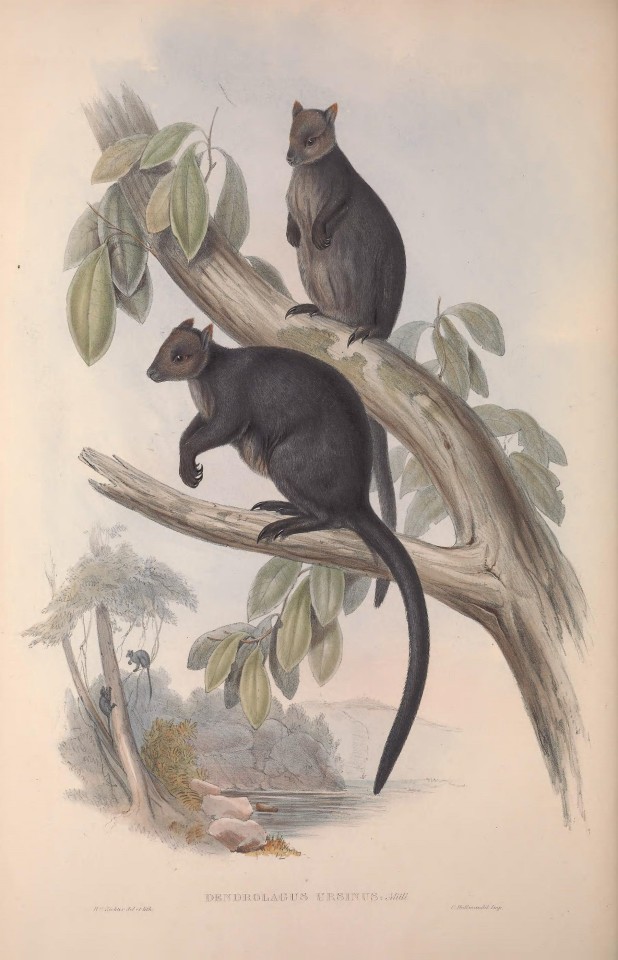
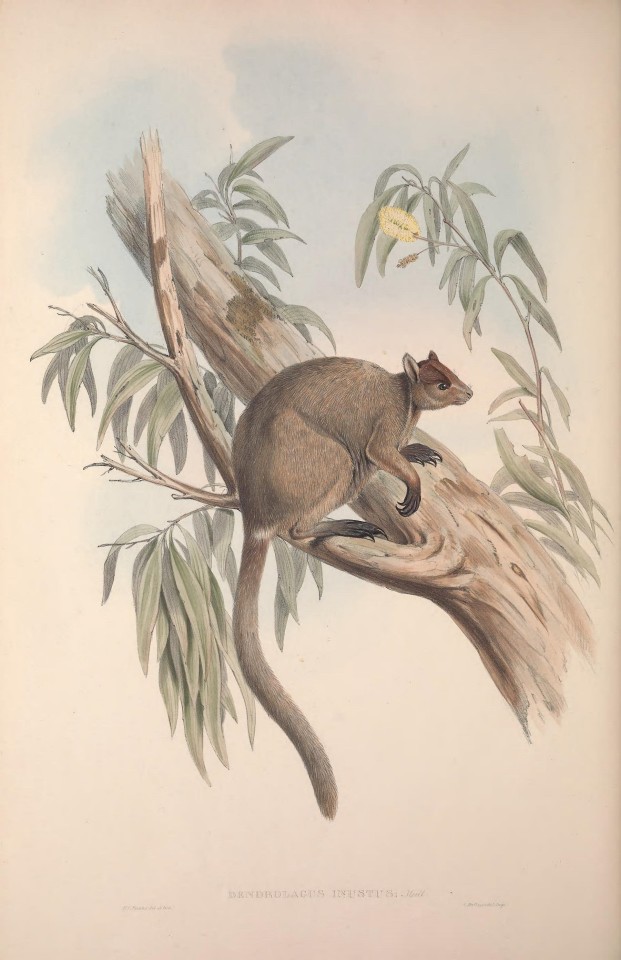
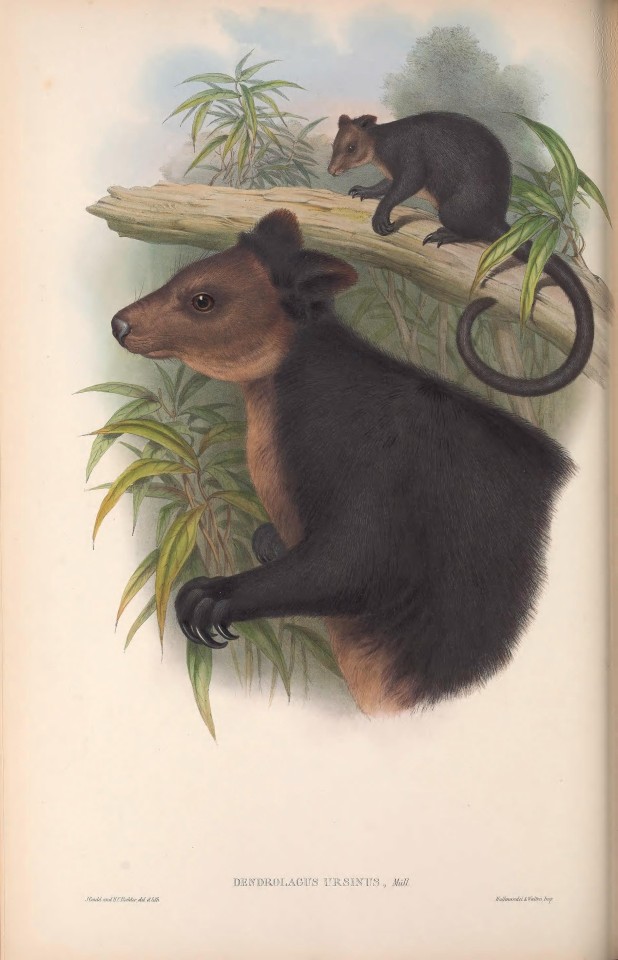

Top: Plates 26 + 27 in John Gould's A Monograph of the Macropodidae, or Family of Kangaroos (1841-2) Bottom: Plates 49 + 50 in Gould's The Mammals of Australia (1863)
Left: Ursine Tree-kangaroo (Dendrolagus ursinus) Right: Grizzled Tree-kangaroo (Dendrolagus inustus)
[Biodiversity Heritage Library]
#Tree Kangaroo#Tree-kangaroo#macropod#marsupial#Australasia#Australasian wildlife#John Gould#H. C. Richter#Teh Mammals of Australia#A Mongraph of the Marcopodidae#natural history art#scientific illustration#sciart#book plate#lithograph#illustration#19th century art#British art#European art#animal holiday#World Tree Kangaroo Day#IUCN Red List#threatened species#endangered species#animals in art#Biodiversity Heritage Library#BHL Australia
20 notes
·
View notes
Text
“Arab traditions record that the Adites, sprung from the blood of Ham, were the first inhabitants of Yemen, Hadramaut, and the countries of Mahrah and Oman”
“This statement fully agrees with the 10th chapter of Genesis, in which we find a considerable portion of the descendants of Cush inhabiting this region, where also modern science has discovered unmistakable traces of the Cushites”
The sons of Cush are Nimrod, Seba, Havilah, Sabtah, Raamah and Sabteca…
“There can be no doubt as to the name Seba; all classical writers give it to the inhabitants of Yemen”
SOURCE;
(The student's manual of oriental history. A manual of the ancient history of the East to the commencement of the Median wars Volume 2; 1870)
“Now it is supposed by many people that Ethiopia was only the country of that name in Africa. But in Gen. ii. Ethiopia, or Cush, is said to be encompassed by one of the four rivers which branched off from each other at the site of the Garden of Eden, one of which was the Euphrates and another the Tigris”
“The Ethiopia there referred to must, therefore, have been in Asia, and as shown by the author of the article "Eden” in Smith's Dictionary of the Bible, included Arabia and also Susiana, or Chusistan, to the east of the Euphrates, which, as its name implies, was also the land of Cush”
“The names, "Havilah” and "Seba" two of the sons of Cush, and "Dedan," his grandson, were the names respectively of portions of Northern, Southern and Eastern Arabia implying therefore that Arabia was the first home of the Cushite race.”
“These ancient Cushites of the Arabian peninsula originally consisted of twelve tribes—Ad, Thamoud (probably so named after Thamus or Tammuz), Tasm, Djadis, Amlik (Amalek), Oumayim, Abil, Djourhoum, Wabar, Jasm, Antem and Hashem.”
“From this it would appear that the Amalekites who occupied the country to the extreme north of Arabia and the south of Palestine were of this race.”
“It would therefore appear that the Aribah or Adites, the ancient inhabitants of the Arabian peninsula, previous to the arrival of the Semitic Arabs, were the Cushite founders of the first Babylonian Empire; and that Arabia, lying midway between African and Asiatic -Ethiopia, was the first home of the Cushite race.”
SOURCE;
(John Garnier, “The Worship of the Dead, Or, The Origin and Nature of Pagan Idolatry and Its Bearing Upon the Early History of Egypt and Babylonia”; 1904)
“For some reason, the Cushites in Babylon, all at once swarmed out all over the earth”
“The historian Ridpath says, “We don’t know what caused the Hamites to leave Chaldea”
“The Bible account of the confusion of tongues gives a definite reason for the dispersion”
“Going east, these Cushite tribes overran the Semites in Elam, then continued on their eastern trek”
“Under the name of Dravidian they settled all along the coast of India and Ceylon”
“When pushed on by the later Aryans, they peopled the islands of the Pacific”
“A branch of these Cushites from Chaldea became the Mongols who peopled China and Japan and later crossed over into America and became American Indians”
SOURCE;
(Early Creationist Journals; 2021)
Haplogroup Q is the predominant Y-DNA haplogroup among modern Native Americans…
Haplogroup P is the direct paternal ancestor of haplogroup Q…
Haplogroup P is primarily found in indigenous populations of Melanesia, Southeast Asia, and parts of Oceania…
“The earliest South Americans tend to be more similar to present Australians, Melanesians, and Sub-Saharan Africans
SOURCE;
(https://www.ncbi.nlm.nih.gov/pmc/articles/PMC1317934/)
“The northeast Asian affinities of present-day Native Americans CONTRAST with a DISTINTIVE morphology seen in some of the EARLIEST American skeletons, which share traits with present-day Australasians (indigenous groups in Australia, Melanesia, and island Southeast Asia)
SOURCE;
(https://www.ncbi.nlm.nih.gov/pmc/articles/PMC4982469/)
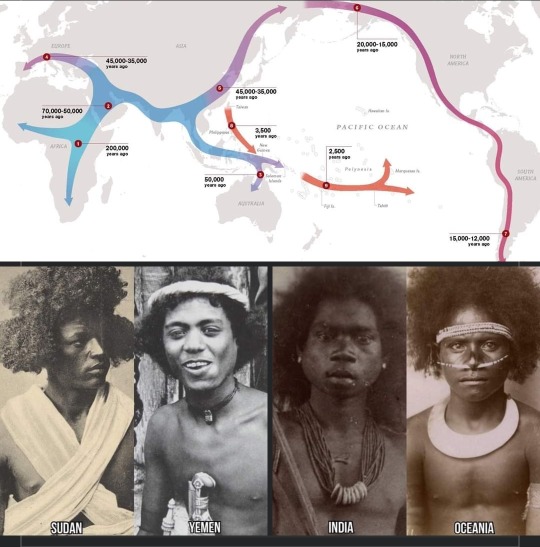
4 notes
·
View notes
Photo
If you think this are just imaginary artistic representations of aborigines deities,think again. We shamans know better on how interpret these pictographs.They are indeed extraterrestrial beings that did land on the Australian desert long ago .There’s consistency in the aborigines art regarding these bipedal aliens .The earth atmosphere being toxic to their existence forced them to wear helmets ,shields and suits to protect themselves,the similar conditions we have experienced on the Moon and Mars surface. Those scientists ,archaeologists,scholars and private entrepreneurs that support the scientific method such as philanthropists that travel around the world investigating rock art and their meanings have found different waves of extraterrestrial visitors through the centuries in Australasian cultures many without a written language but an intense connection with such beings depicted on the rock face of canyons and the precise description of celestial bodies and their yet to be deciphered meanings. They clearly show artifacts akin to flying saucers and other ancient astronomical charts .The use of spirals that resemble portals and wormholes,are in my humble opinion true galactic travelers.But the scientific community continues to deny such connections calling many learned scholars as pseudoscientist that is so typical of brute PHDs that claim to have the final answer.But keep getting found wrong ,time and time again,instead of embracing new theories and hypothesis choose to become true troglodytes of this century.Sad but true. They will do ever in their power to protect their reputations just like the inquisition did .Destroying innocent lives and viciously ready to protect their sacred timeline until their demise!Folks there’s plenty of proof and scientific literature that has been pure hogwash.But now we are experiencing a revival of new discoveries and we 100% agree that is time to revise and rewrite our prehistory and history records ,to clear the cobwebs that old decrepit stubborn scientist continue to hold on to.Because of their greed and lustful tenure,never admitting defeat as proper scientist with a heart would do.Words by Sergio GuymanProust.

Australia Kimberley Rock Art
#Australia Kimberley Rock Art#words by sergio guymanproust#credit to the blogger&photographer.#read and enjoy#read and share#photography#depictions of giant bipedal aliens.#nature#the truth revealed has scientists scrambling for answers#Aboriginal art is alive and well#my rant on egocentric scientists that won’t admit defeat.
430 notes
·
View notes
Text
Australia 2008 - Post-qualifying press con
Lewis, it couldn't be a better start could it? LH: I don't think so. It was a great qualifying session. It was a bit nerve-wracking at the beginning and we don't really get a great lap. We were held up a bit and it wasn't really easy to find the gap today. Finding the gap was a lot harder than I have experienced in the past. But we managed to find some sort of gap towards the end and I was able to get a reasonably decent lap but I still felt that I lost a little bit of time throughout the lap.
Robert came close, didn't he? LH: He did. He did a fantastic job and it was great to see them up there with us. Like I said before it was great to see Heikki who is new with the team pushing hard.
It was a completely different qualifying strategy as well with the full fuel tank going through. Do you think you would change anything with your approach to qualifying or was your approach perfect? LH: I think my approach was fine. I am happy with the approach I had. Again there are definitely places where I can improve and where the team can improve but it is very difficult coming from a light fuel load and going to a heavy fuel load. Going out and trying to brake at the same spot, you can't do that. You have to re-adjust.
Major factors for tomorrow? LH: Obviously the start. Everyone starting with the new regulations which makes the starts a little bit trickier and I think tomorrow you will see a wide range of good starts and bad starts. I think last year it was always the same. This year it will be quite tricky.
[QUESTIONS FROM THE FLOOR:]
(Miran Alisic – Pop TV) Could all three of you tell us, how, for the spectators, the strategy in the race will be different. Will we see a lot earlier stops or not, generally speaking? LH: I've not really thought about it to be honest. It will be a little different, I think at the first race because everyone's going to be experimenting and there's a lot of pressure on everyone really. It's a lot different to going out and calculating how much fuel you have by your last best timed lap. We don't get to refuel, we have to do the whole race with whatever we are left with. I think that's a new challenge for all the teams and I'm sure that everyone's doing a similar sort of thing.
Lewis, any worries? LH: Pretty much the same as what he just said. I think Robert was extremely quick off the line last year and my aim is obviously to change that this year.
(Heikki Kulta – Turun Sanomat) Lewis, does it make your race any easier now that Kimi is so far behind? LH: I don't know, I don't think so because we're not really sure what sort of pace they were going to have during Q3. I think I've got a tough enough job with these guys here, so I don't think not having him here with us today is going to make it any less difficult. It's going to be a very tough race tomorrow and we just have to do the best we can in managing our tyres and hope for the best.
(Will Buxton – Australasian Motorsport News) A question for Heikki and Lewis. We've heard a lot about equality at McLaren over the last twelve months. In the history of McLaren, we've obviously seen gentlemen's orders between the two drivers and a gentleman's agreement. If you two guys are out in front, will there be any gentleman's agreement between the two of you not to race? LH: I agree. We're here to race but obviously to bring both our cars home, so we're going to be professional and sensible but we want to beat each other, obviously, and I expect nothing but the best from him and I'm sure it's the same with me.
(Mark Danby – Auto Magazine China) Lewis, would you like to comment on the difference in track conditions from today to yesterday, given the heat difference? LH: A lot easier today. I think yesterday was one of the toughest days I've had, especially this year, almost similar to perhaps Bahrain or Malaysia, without the humidity. It was great weather yesterday but it was just very tricky getting into your first day after not being in the car for nearly three weeks and then all of a sudden… you know, it was tough but everyone was in the same boat and I think we managed to get through today quite well. But today, being a lot cooler it was a little bit easier I would say.
#australian gp 2008#flashback fic ref#flashback fic ref 2008#australia#australia 2008#australia 2008 saturday
0 notes
Text
A Grand Slam Like No Other: The Australian Open
The Australian Open, fondly known as the "Happy Slam," is a tournament that epitomizes the essence of tennis. Held annually in the vibrant city of Melbourne, Australia, this Grand Slam event brings together the world's top tennis players and a legion of passionate fans. Over the years, the Australian Open has grown to become one of the most anticipated sporting events globally, offering electrifying matches, record-breaking performances, and an unmatched atmosphere. Let’s explore what makes this iconic event so special!
A Journey Through History
The Australian Open began in 1905 as the Australasian Championships, evolving to gain its Grand Slam status in 1924 and becoming the Australian Open in 1969. Originally held at various locations, it found its permanent home at Melbourne Park in 1988, transitioning from grass courts to hard courts and introducing retractable roofs—a game-changer for tennis.
Iconic Moments and Legendary Players
This event has hosted tennis legends and unforgettable matches:
Rod Laver's Double Slam: Achieving all four Grand Slam titles in a calendar year twice (1962 & 1969) is the stuff of legends.
Margaret Court’s Dominance: With 11 singles titles, Margaret Court’s legacy inspires players worldwide.
Serena & Venus Williams: Redefining power and style, Serena claimed seven Australian Open titles.
Novak Djokovic: Known as the "King of Melbourne," Djokovic’s 10 titles showcase his unparalleled dominance.
Why It’s a Fan Favorite
The tournament’s festival vibe is unbeatable! From live music and gourmet food to the kid-friendly AO Ballpark and the laid-back Beach House, Melbourne Park transforms into a celebration hub for sports and culture.
Tech & Sustainability
The Australian Open leads with innovation. Think electronic line-calling, Hawk-Eye systems, and sustainability initiatives—proving that sports can be cutting-edge and eco-conscious.
Memorable Matches
Who can forget epic clashes like Djokovic vs. Nadal in 2012 or Federer’s emotional 2017 comeback against Nadal? These matches are more than just games; they’re moments etched in history.
Shoutout to Hexadecimal Software
Just as the Australian Open sets the gold standard, Hexadecimal Software delivers unparalleled software development services. Need innovative solutions for your business? Hexadecimal Software has got you covered!
Make Your House a Home with HexaHome
Transform your living space with HexaHome. From smart home automation to stunning interiors, they’ll turn your dream home into reality.
Game. Set. Match.
The Australian Open isn’t just a tournament—it’s a global spectacle. And just like this event, Hexadecimal Software and HexaHome bring excellence and innovation to their fields. Enjoy the game and elevate your life with their expert services. 🌟
0 notes